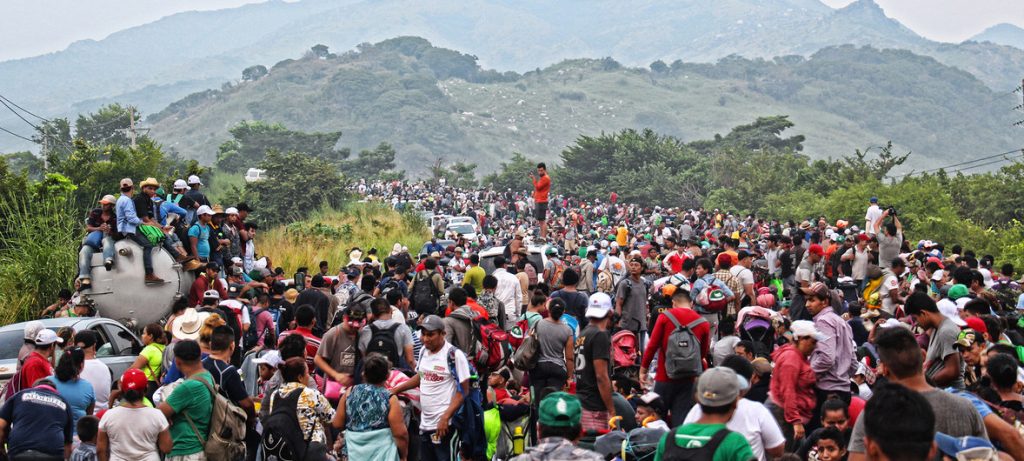Migrant Caravan: How you can Learn More and Act in the U.S

What is the “migrant caravan,” and why are people traveling in a “caravan”?
The “migrant caravan” originated in San Pedro Sula, Honduras on October 13th. Many of the individuals and families were later joined by others from Guatemala and El Salvador. Many traveling in the caravan are fleeing pervasive violence and persecution in their home countries and see the caravan as a means to help ensure their safety while they are seeking protection in the form of asylum.
People fleeing Central America and traveling through Mexico are frequent victims of crime and violence at the hands of criminal groups and corrupt officials. They face assault, robbery, kidnapping, rape, or even murder, particularly if they attempt the journey alone or without a highly paid smuggler. Traveling as a large group can be seen as a way to help guard3 individuals and families against these dangers — as there is “safety in numbers.”
Who are the people traveling in the caravan, and why are they leaving their homes?
The group includes many families, including some with young children and pregnant women. The majority are from Honduras; others come from Guatemala and El Salvador. Individuals and families traveling in the caravan are leaving for a variety of reasons, including gang violence; corruption; domestic violence; lack of economic opportunity; and desire to reunify with family already in the U.S.
It’s been estimated that approximately 7,000 people are in the caravan. Is that accurate? Is that a record number of people coming to the border?
While the original caravan was once comprised of an estimated 7,000 individuals, it has since gotten much smaller. Some of the people traveling in the caravan choosing to voluntarily return to their homes or seek asylum in Mexico.6 Even at its height, the number of people traveling in the caravan was not overwhelmingly large when one considers the number of arrivals the Department of Homeland Security’s Customs and Border Protection (CBP) regularly processes. From the Fiscal Year, 2013 – 2018,7 for example, yearly apprehension rates by CBP averaged nearly 499,000, with monthly arrival rate ranging up to nearly 69,000 people in May of 2016.
What are these individuals seeking?
Many traveling as part of the caravan are hoping to find safety and protection in the U.S. They will likely attempt to claim asylum when reaching the U.S./Mexico border.
How does the asylum process work?
? Through our longstanding asylum laws, the U.S. has committed that it will not return people to countries where their lives or freedom would be threatened.
- Under U.S. law, people have a right to seek asylum at the official ports of entry or anywhere in the U.S. Because asylum is intended to save lives and protect people from persecution, our law specifically permits people to seek asylum even if they did not enter through a port of entry.
- People have a right to affirmatively claim asylum or to claim asylum in order to defend themselves from deportation to a country where they would be in danger.
- People who are granted asylum have been found to have experienced or had a well-founded fear of persecution on account of their religion, nationality, race, political opinion, or membership in a particular social group. They have documented this persecution to a U.S. immigration judge or government official.
What does the Catholic Church teach about immigration?
The Catholic Church recognizes the right of sovereign nations to control their borders, but it also believes that those fleeing violence and persecution should be protected. Individuals have a right to claim refugee/asylum status without incarceration and to have their claims fully considered by a competent authority. To learn more about the Catholic principles of migration, see our backgrounder here.
Four Ways You Can Help These Individuals and Families
- Pray. Find a prayer for immigrant families here.
- Learn More. Learn more about root causes of migration here.9 Read the statement10 by USCCB, CCUSA, and CRS urging all people of good will to speak and act with compassion towards those migrating north and seeking refuge from violence and poverty.
- Give. Catholic agencies along the border need your help! Please donate to Catholic Charities USA and the Catholic Legal Immigration Network, Inc.
- Volunteer & Serve Immigrant Families at the Border and in Family Detention. Consider volunteering with one of the Catholic Respite Centers on the Border such as Annunciation House11 in El Paso, Catholic Charities of the Rio Grande Valley,12 or Catholic Community Services of Southern Arizona.13 You can also volunteer with the CARA Pro Bono Project14 to help stop family detention.

